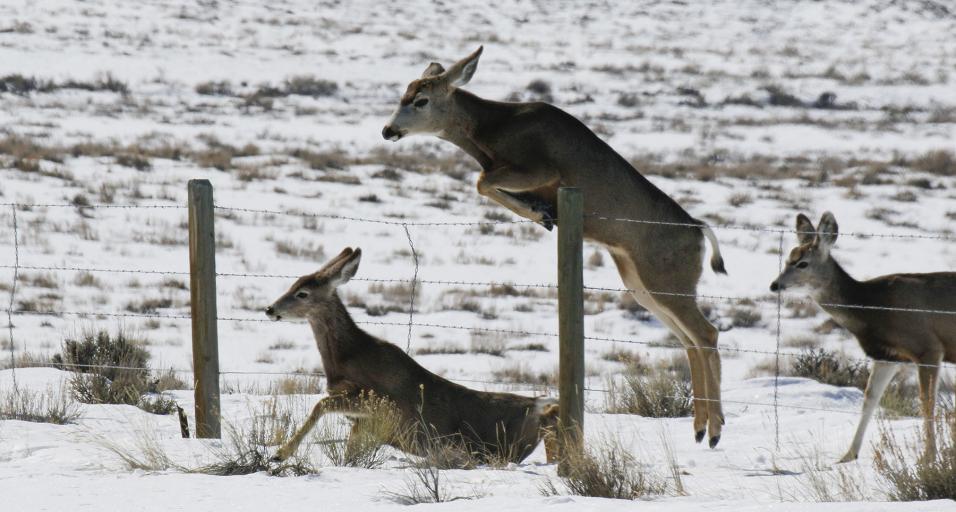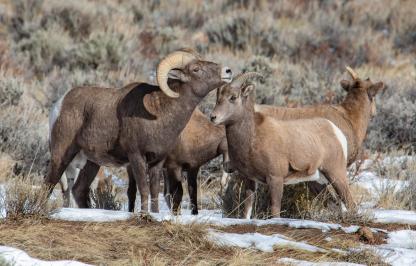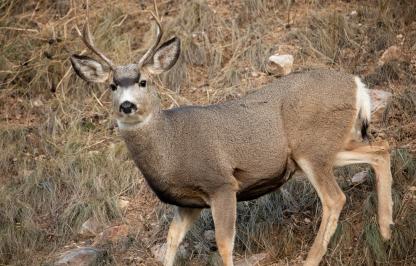It’s that time of year when Wyoming’s abundant big game herds are on the move, transitioning to their lower elevation winter ranges where there is less snow. This puts them in closer proximity to people and forces them to negotiate a number of obstacles such as roadways, fences and so on, that are part of human development. We can do a number of things to make the winter months less stressful and help them survive their most difficult time of year.
As motorists, we can plan ahead so that we can drive slower and pay closer attention for animals along our roadways. Research has shown that wildlife-vehicle collisions occur at a higher rate at during the winter months and that slowing down, even just five miles per hour can greatly increase a driver’s reaction time to avoid a collision. This is especially important at dawn and dusk, when animals are more active and harder to see. Clearly no one wins in a wildlife-vehicle collision. Typically the animal dies and motorists can be injured as well. At a minimum, the vehicle owner will have a hefty bill for vehicle repairs.
As landowners, we can help big game animals move more freely across the landscape by leaving fence gates open where possible. This can be especially important with gates along roadways to allow animals out of the road right-of-way. This can also help reduce damage to fences and prevent animals from getting entangled and dying. Many landowners have modified their fences to make them more wildlife-friendly by replacing the bottom wire with a smooth wire and lowering the top wire or adding a pole to the top. There are often funding programs, and sometimes volunteers, available to help landowners make these changes.
As mule deer and other big game make their annual migration to winter ranges, the Wyoming Game and Fish Department reminds citizens to watch for poachers or suspicious activity, and to report any illegal activity immediately. Mule deer from the Sublette and Wyoming Range herds spend the winter in the Pinedale/Big Piney/LaBarge area. Although trophy mule deer can be difficult to find in the vast backcountry during hunting seasons, they are more visible, and more vulnerable, as they transition to winter ranges.
“We end our hunting seasons when we do to protect these animals during the winter months when they are more vulnerable,” said Game and Fish Regional Supervisor John Lund. “These deer face many challenges, and blatant illegal shooting is especially disturbing.”
Game wardens continue to focus their attention on these mule deer winter ranges, but they still need help. “We do not have the personnel to be everywhere, all the time, so we rely on reports from the public,” said Lund. “There are quite a few people out there watching the deer and their reports of suspicious activity can be extremely helpful. Whether you’re a hunter or just a wildlife enthusiast, the illegal shooting of these animals should not be tolerated by anyone.”
To report a wildlife crime, please call the Stop Poaching Hotline at 1-877-WGFD-TIP or file a report on the Wyoming Game and Fish Department website. Callers can remain anonymous and may be eligible for a cash reward if a conviction is made.
Also, the seasonal winter closure for shed antler and horn hunting begins on Jan. 1 for many sections of public land, state land and Wyoming Game and Fish Commission wildlife habitat management areas throughout Wyoming. The closures help protect wintering big game by limiting stress so they can better survive the harsh winter months. For more information on the collection of shed antlers and horns, visit the Wyoming Game and Fish Department website.
WGFD: Helping Wildlife During Winter
Mark Gocke, Public Information Specialist, 307-249-5811




